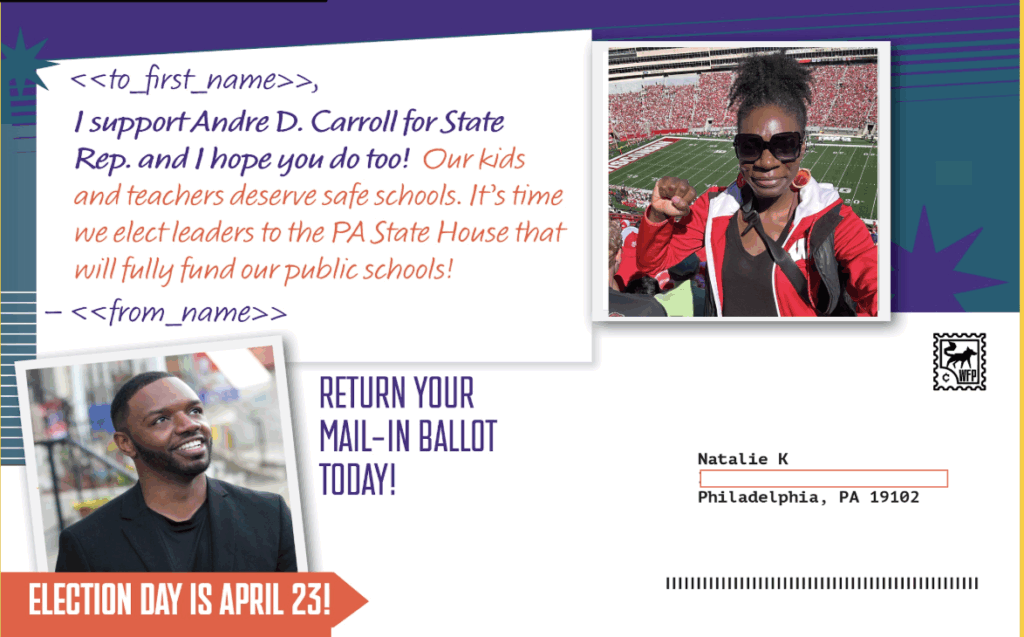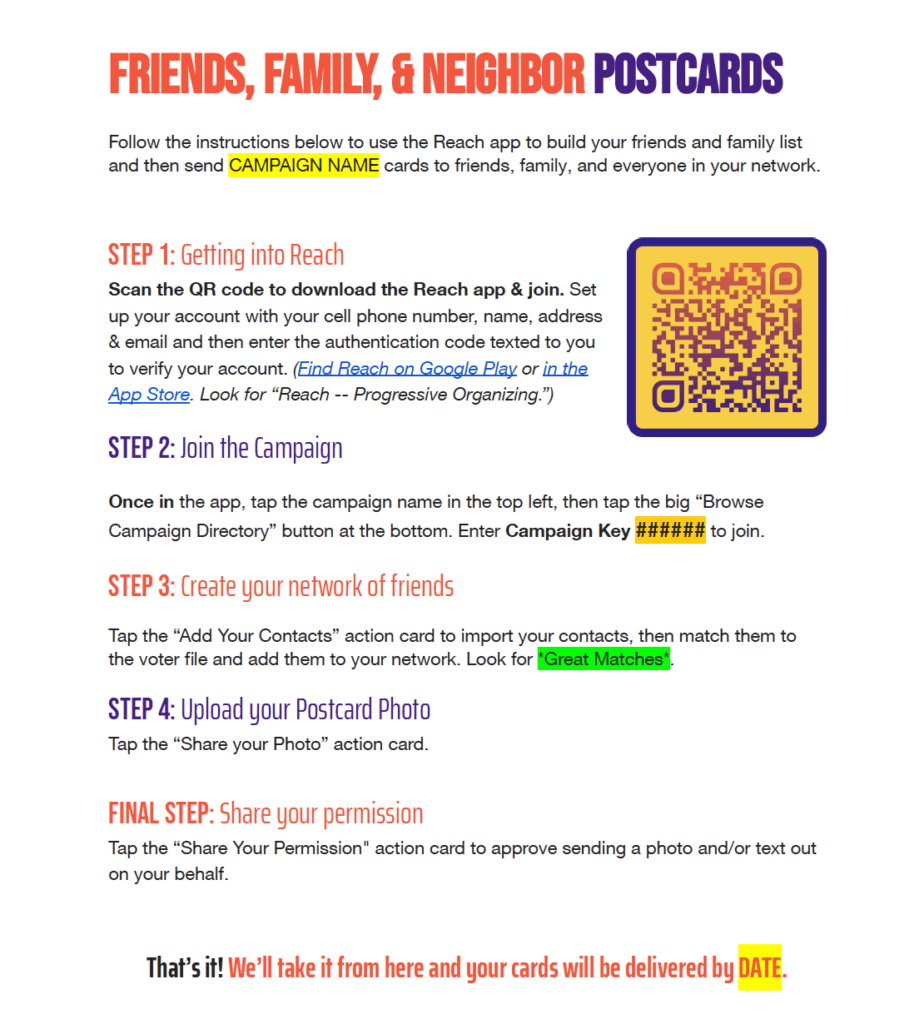Background
The Working Families Party (WFP) is a progressive political party that recruits, trains, and elects transformational leaders across the country using innovative strategies to mobilize voters and drive grassroots engagement in elections.
In 2022, WFP developed a creative use of Reach’s Relational Organizing feature: have volunteers map their relational networks and upload a picture of themselves for WFP to mail a printed postcard with the volunteer’s photo to their network. The personalized postcards focused on a message of support for WFP candidates and issues. As the 2024 election season approached, WFP aimed to scale these efforts to increase voter participation and engagement, using Reach to centralize, streamline, and scale their relational postcard program effectively.

Goals for 2024
The WFP had ambitious goals for 2024 and understood that scaling the program would require a phased approach and more reliance on the tools available to them in Reach.
- In 2022, they sent 20,000 postcards from 300 participants
- In 2023, they sent 60,000 postcards from 500 participants
- In 2024, they aimed to ramp up to 100,000 postcards with at least 1,000 participants. Read on to see how they exceeded this goal!
How Reach Fit into Their Strategy
Reach was the cornerstone of WFP’s relational postcard program. Prior to using Reach, WFP had experimented with different digital tools and methods, including a photo-based postcard tool they commissioned. While this tool allowed users to design and share postcards, it lacked integration with a broader system and was more reliant on volunteers to handle logistics like printing and mailing, making the program less effective.
In 2024, WFP recognized that Reach’s centralized platform could streamline the entire postcard process, from data management to volunteer engagement. By working closely with Reach’s team, WFP used key Reach features that improved the program:
- File Upload Action Cards: Developed specifically for WFP’s program, volunteers could easily upload photos in Reach for the WFP team to access and download. The photos could be forced into square aspect ratio at capture-time and resized and reformatted on the back end using URL parameters.
- Contact Import: With Reach, volunteers could easily import their contacts and match them to the voter file, ensuring a personalized touch while maintaining a high level of precision in targeting.
- Centralized Process: All of the components – from photo to network to permissions – were done using Reach. This reduced logistical headaches and allowed WFP to track program performance in real-time.
Why Reach?
WFP had used Reach for relational organizing, and they knew that the platform’s contact import and data matching features were essential for a program that relied heavily on personal connections. The ability to use Reach to maintain data integrity, ensuring that contacts were matched to the correct record in the voter file and avoiding errors in the process was essential. That’s because volunteers weren’t just providing a list of friends, they were using Reach to match their friends and neighbors to the voter file, providing WFP with a ready-to-go, easily exportable list. That made for fewer errors, an easier administrative experience, and a better volunteer experience.
By leveraging Reach, WFP was able to:
- Remove the burden of printing and mailing from volunteers’ hands by making it easy for volunteers to get all the necessary materials to the WFP right in Reach.
- Ensure image aspect ratio and resolution
- Ensure permissions were gathered for every piece of mail sent.
Reach’s flexibility and user-friendly interface were key factors in WFP’s decision to centralize the postcard program on Reach.
Recruiting and Training Volunteers
Running a postcard program of this scale requires significant organizing capacity. WFP’s team used a combination of methods to recruit volunteers:
- Member outreach: The organization tapped into its existing base of members and supporters.
- Partner organizations: WFP collaborated with other progressive groups and community leaders.
- Field canvassing: In some cases, postcard recruitment was combined with in-person canvassing efforts to recruit and train volunteers.
Training volunteers was also an essential part of scaling the program. Volunteers were trained through:
- Virtual events: These weekly trainings were attended by 15-20 people a session and typically took around 15 minutes, followed by a Q&A to address specific concerns.
- In-person events: These were especially successful with up to 50 attendees. Being in person allowed trainers to ensure volunteers were properly understanding the process and completing tasks correctly.
- DIY materials: Volunteers received one-page instructions for each campaign, and WFP also created a Typeform for volunteers to follow along with the steps.
- In 2025, programs have focused recruitment on working with partners to set up joint trainings or opportunities at existing events to share the postcard tactic and walk folks through how to do it. While past trainings were usually in English, WFP is now experimenting with a bilingual postcard program that includes trainings and materials in Spanish.

The most successful training efforts combined in-person events with DIY materials that allowed volunteers to independently get up to speed.
Data Management & Internal Operations
Meticulous data management is a must for a program like this. The WFP team stressed the importance of having a strong project manager and a detail-oriented data team to handle the various stages of the program:
- Processing Data: Volunteers submitted photos, permissions and contact networks via Reach.
- Quality Control: Reach’s data matching ensured that volunteer photos and contact details matched the voter file correctly and that permissions were granted per campaign.
- Data Privacy: Volunteers trusted WFP with sensitive personal data (photos and contact information), so proper care was taken to ensure compliance with privacy standards and clear communication about how their data would be used.
The data was handed off to a vendor who printed the postcards and handled the mailing. WFP’s internal team continued to monitor the process to ensure everything ran smoothly.
What Worked: Key Features of Reach
The most powerful aspect of Reach for WFP’s postcard program was its ability to centralize the process. Volunteers could easily upload photos, import contacts, and track the entire process in one place. Additionally, Reach allowed WFP to:
- Centralize Volunteer Asks: All of the volunteer tasks could be completed in Reach, from uploading a photo to granting permissions.
- Automate postcard printing and mailing: Allowing volunteers to provide images and pre-matched networks in Reach, meant volunteers no longer had to worry about printing and postage, reducing the manual work involved and creating the ability for WFP to handle printing, mailing and tracking.
- Improve relational engagement: Once postcards were delivered, recipients often texted the volunteer whose photo was on the card, beginning an organic conversation and building stronger relational connections.
Whether it’s volunteer recruitment, early vote reminders, or issue-based messaging, these cards help organizers turn outreach into action—while allowing flexibility and personal touch.
– A WFP 2025 Postcarding Volunteer
Impact and Results
WFP’s relational postcard program was a resounding success, with the campaign seeing the following results:
- The program grew substantially, with postcard numbers increasing year over year:
- 2022: 20,000 postcards from 300 participants.
- 2023: 60,000 postcards from 500 participants.
- 2024: Over 140,000 postcards from more than 1,200 participants.
- 2025: More than 56,000 postcards from over 750 participants for just the March Wisconsin Supreme Court race.
- Turnout analysis revealed an 85% overall turnout rate among postcard recipients, with over 50% having scores of 90+.
- Higher turnout scores correlated with actual turnout, with the 40s-50s score range achieving approximately 50% voter turnout.
- Demographic analysis showed similar racial and income patterns between recipients and senders, supporting demographic matching in order to engage diverse audiences.
- Engagement scores indicated that about 66% of recipients scored 90+ on persuasion metrics, 75% scored 70+. Postcard recipients showed higher average turnout scores than other outreach attempts.
Once a volunteer participates, it’s easy for WFP to reactivate them for future campaigns, leveraging the data they’ve gathered. The program’s efficiency and scalability continued to improve, thanks to the ability to easily onboard new volunteers and manage growing volumes of postcards.
Conclusion
The Working Families Party’s use of Reach to scale its relational postcard program in 2024 proved to be a game-changer. With the help of Reach’s platform, WFP was able to centralize processes, track data more effectively, and ultimately expand their program to engage more volunteers and reach more voters. The ability to easily import contacts, match data to the voter file, and streamline the logistics allowed WFP to focus on what really mattered: building deep, meaningful connections with voters.
For any organization looking to scale their relational organizing efforts in the 2025/2026 election cycle and beyond, Reach provides the tools and support to ensure success.